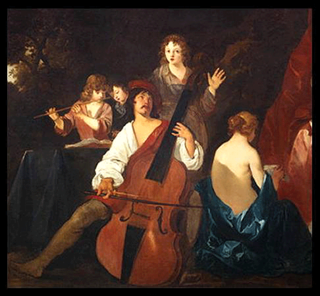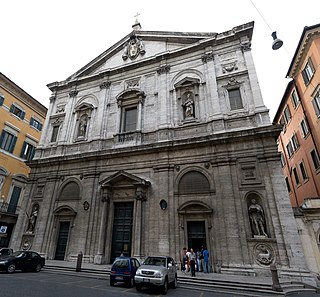
Pope Alexander VIII, born Pietro Vito Ottoboni, was Pope from 6 October 1689 to his death in 1691. He is the last pope to take the pontifical name of "Alexander" upon his election to the papacy.

Giuseppe Domenico Scarlatti was an Italian composer. He is classified primarily as a Baroque composer chronologically, although his music was influential in the development of the Classical style and he was one of the few Baroque composers to transition into the classical period. Like his renowned father Alessandro Scarlatti, he composed in a variety of musical forms, although today he is known mainly for his 555 keyboard sonatas. He spent much of his life in the service of the Portuguese and Spanish royal families.

Arcangelo Corelli was an Italian violinist and composer of the Baroque era. His music was key in the development of the modern genres of sonata and concerto, in establishing the preeminence of the violin, and as the first coalescing of modern tonality and functional harmony.
The concerto grosso is a form of baroque music in which the musical material is passed between a small group of soloists and full orchestra. This is in contrast to the solo concerto which features a single solo instrument with the melody line, accompanied by the orchestra.
The trio sonata is a genre, typically consisting of three or four movements with contrasting two melody instruments and a continuo. Originating in the early seventeenth-century, the trio sonata was a favorite chamber ensemble combination in the Baroque era.

Bernardo Pasquini was an Italian composer of operas, oratorios, cantatas and keyboard music. A renowned virtuoso keyboard player in his day, he was one of the most important Italian composers for harpsichord between Girolamo Frescobaldi and Domenico Scarlatti, having also made substantial contributions to the opera and oratorio.
Johann David Heinichen was a German Baroque composer and music theorist who brought the musical genius of Venice to the court of Augustus the Strong in Dresden. Heinichen's music lingered in obscurity for a long time.

The term violone can refer to several distinct large, bowed musical instruments which belong to either the viol or violin family. The violone is sometimes a fretted instrument, and may have six, five, four, or even only three strings. The violone is also not always a contrabass instrument. In modern parlance, one usually tries to clarify the 'type' of violone by adding a qualifier based on the tuning or on geography, or by using other terms that have a more precise connotation. The term violone may be used correctly to describe many different instruments, yet distinguishing among these types can be difficult, especially for those not familiar with the historical instruments of the viol and violin families and their respective variations in tuning.

Pietro Ottoboni was an Italian cardinal and grandnephew of Pope Alexander VIII, who was also born Pietro Ottoboni. He is remembered especially as a great patron of music and art. Ottoboni was the last person to hold the curial office of Cardinal-nephew, which was abolished by Alexander's successor, Pope Innocent XII, in 1692. Ottoboni '"loved pomp, prodigality and sensual pleasure, but was in the same time kind, ready to serve and charitable".
The archlute is a European plucked string instrument developed around 1600 as a compromise between the very large theorbo, the size and re-entrant tuning of which made for difficulties in the performance of solo music, and the Renaissance tenor lute, which lacked the bass range of the theorbo. Essentially a tenor lute with the theorbo's neck-extension, the archlute lacks the power in the tenor and the bass that the theorbo's large body and typically greater string length provide.
Domenico Gabrielli was an Italian Baroque composer and one of the earliest known virtuoso cello players. Born in Bologna, he worked in the orchestra of the church of San Petronio and was also a member and for some time president (principe) of the Accademia Filarmonica of Bologna. During the 1680s he also worked as a musician at the court of Duke Francesco II d'Este of Modena.

Baroque music of the British Isles bridged the gap between the early music of the Medieval and Renaissance periods and the development of fully fledged and formalised orchestral classical music in the second half of the eighteenth century. It was characterised by more elaborate musical ornamentation, changes in musical notation, new instrumental playing techniques and the rise of new genres such as opera. Although the term Baroque is conventionally used for European music from about 1600, its full effects were not felt in Britain until after 1660, delayed by native trends and developments in music, religious and cultural differences from many European countries and the disruption to court music caused by the Wars of the Three Kingdoms and Interregnum. Under the restored Stuart monarchy the court became once again a centre of musical patronage, but royal interest in music tended to be less significant as the seventeenth century progressed, to be revived again under the House of Hanover. The Baroque era in British music can be seen as one of an interaction of national and international trends, sometimes absorbing continental fashions and practices and sometimes attempting, as in the creation of ballad opera, to produce an indigenous tradition. However, arguably the most significant British composer of the era, George Frideric Handel, was a naturalised German, who helped integrate British and continental music and define the future of the classical music of the United Kingdom that would be officially formed in 1801.

StefanoBernardi, also known as "il Moretto", was an Italian priest, composer and music theorist. Born in Verona and maestro di cappella at the Verona Cathedral from 1611 to 1622, he later moved to Salzburg, where he was responsible for the music at the Salzburg Cathedral and composed a Te Deum for 12 choirs performed at the cathedral's consecration in 1628.

Aure soavi e liete is a Baroque dramatic secular cantata in the key of E-flat major composed by George Frideric Handel in 1707 while he was serving as Kapellmeister to the Ruspoli family in Rome. The author of the text is unknown. Other catalogues of Handel's music have referred to the work as HG l,12. The cantata is scored for solo soprano voice and basso continuo. It is divided into four separate movements with a typical performance lasting approximately seven and a half minutes.
Tommaso Bernardo Gaffi was an Italian baroque composer. He was a pupil of Bernardo Pasquini, organist of the church of Santa Maria Maggiore, where Gaffi succeeded him in 1704. As Pasquini he enjoyed the patronage of cardinals Benedetto Pamphili and Pietro Ottoboni, as well as Prince Francesco Maria Ruspoli. His own students included Girolamo Chiti and Andrea Basili.
Alfred Planyavsky was an Austrian double-bassist and music historian.
Carlo Francesco Cesarini, also known as Carlo del Violino, was an Italian composer and violinist born near Urbino and active in Rome from 1690. In 1690 he entered into the service of Cardinal Benedetto Pamphili as the director of his music academy and probably remained in his service until the cardinal's death in 1730. Cesarini also served as the maestro di cappella in several Roman churches, including the Chiesa del Gesù from 1704. He composed numerous oratorios and cantatas and was the joint composer of several operas. The opera Clearco in Negroponte which he composed with Giovanni Lorenzo Lulier and Tommaso Gaffi inaugurated the public opening of the Teatro Capranica on 18 January 1695. The last known records of him date from early September 1741 and document his retirement as the maestro di cappella of the Chiesa del Gesù due to ill health. Several individual pieces of his vocal music were published in the 20th century.
Antonio Maria Montanari was an Italian violinist and composer of the Baroque period.












